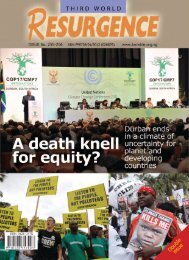Plantations, poverty and power - Critical Information Collective
Plantations, poverty and power - Critical Information Collective
Plantations, poverty and power - Critical Information Collective
You also want an ePaper? Increase the reach of your titles
YUMPU automatically turns print PDFs into web optimized ePapers that Google loves.
97<br />
Nepal<br />
In Nepal, the target area for tree planting under the Bank’s Sagarnath Forestry Development Project was<br />
reduced from 10,000 hectares to 4,140 hectares. Among the problems were “Shortage of staff, inadequate<br />
delegation of authority <strong>and</strong> responsibility, lack of flexibility in administration <strong>and</strong> overcentralization of<br />
decision-making”, according to the Bank’s 1994 overview of its lending to the forestry sector. 494<br />
Another ADB project in Nepal, titled “The hill forest development project,” initially aimed to plant<br />
30,000 hectares. This was subsequently reduced to 10,000 hectares, but at project completion,<br />
“plantations <strong>and</strong>/or improved management practices” had been established on about 7,000 hectares. A<br />
third project aimed to establish fuelwood plantations on two project sites. On one project site, at<br />
Nepalganj, 1,737 hectares was planted (compared to a target of 5,000 hectares) “primarily because of<br />
encroachment by squatters”. 495 Rather than describing local people as “squatters”, it would be more<br />
appropriate to describe the Bank’s plantations as squatting on the l<strong>and</strong> of local people.<br />
Indonesia<br />
A series of ADB loans have supported the expansion of the pulp <strong>and</strong> paper industry in Indonesia, the<br />
result of which has been massive deforestation <strong>and</strong> destruction of local livelihoods. In 1988, the ADB<br />
awarded a contract to Jaakko Pöyry, to identify sites for the development of the pulp industry in<br />
Indonesia. Pöyry went on to win further contracts with Asia Pulp <strong>and</strong> Paper (APP) <strong>and</strong> Asia Pacific<br />
Resources International (APRIL) to design some of the biggest pulp mills in the world. The resulting<br />
dem<strong>and</strong> for timber has led to the destruction of hundreds of thous<strong>and</strong>s of hectares of forest. (See section<br />
on Pöyry, above.)<br />
In 1990, the ADB agreed a US$33.3 million loan to Indonesia for a Timber Plantation Project. The<br />
project ran into several problems. In the end, only US$17.33 million was disbursed. Of the target area of<br />
51,000 hectares to be planted with fast-growing tree plantations, 26,920 hectares was established under<br />
the project. It turned out that the “unproductive shrubs <strong>and</strong> grassl<strong>and</strong>s” that the ADB’s experts planned to<br />
plant with trees were already in use; some areas by local communities, others were allocated for<br />
hydro<strong>power</strong> <strong>and</strong> irrigation dams. In West Kalimantan, the company carrying out the planting, Inhutani III,<br />
clashed with Indigenous People. An Indonesian NGO, the Institute of Dayakology Research <strong>and</strong><br />
Development, accused Inhutani III of using force in taking over l<strong>and</strong>s from indigenous communities. The<br />
Bank hired a consultant for a few weeks <strong>and</strong> rejected the allegations, although the project area was<br />
reduced to exclude “areas where potential l<strong>and</strong> tenure claims could rise”. 496<br />
The ADB’s Project Completion Report describes the damage to the plantations by fires <strong>and</strong> failing<br />
species as “staggering”. The tree species selected for the project “were not based on proven field trials,<br />
<strong>and</strong> were not sufficiently reassessed during site planning <strong>and</strong> preparation of plantation site designs.” 497<br />
494 “Sector synthesis of post-evaluation findings in the forestry sector”, Asian Development Bank, Post-Evaluation<br />
Office, August 1994.<br />
495 “Sector synthesis of post-evaluation findings in the forestry sector”, Asian Development Bank, Post-Evaluation<br />
Office, August 1994.<br />
496 “Project Completion Report Timber Plantation Project (Indonesia) (Loan No. 1000-INO)”, Asian Development<br />
Bank, 11 December 1998.<br />
497 “Project Completion Report Timber Plantation Project (Indonesia) (Loan No. 1000-INO)”, Asian Development















